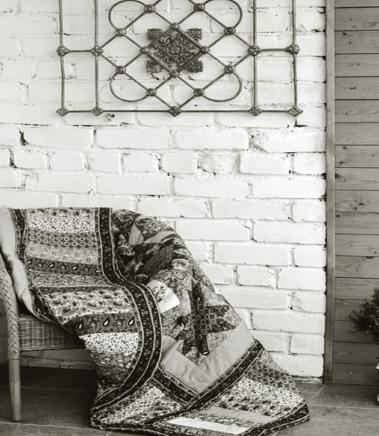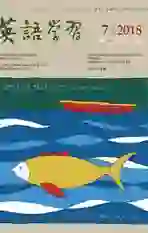缝合历史
2018-08-06ByJenniferBragg
By Jennifer Bragg
W hen my grandmother died at the age of 96 in 2015, there were two things she left behind in abundance: photo albums documenting decades of travel and home life, and her quilts.1 I was living in China at the time of her death, and I couldnt come home for the funeral. Instead, I wrote a brief message that my father read on my behalf, recalling some of my fondest memories of her. She loved birdwatching and we used to write letters back and forth to each other, even when I was living abroad. I thought we always had a unique connection.
My grandmother lived alone for almost 20 years. After her death, my mother and her brother went through her home to sift through2 her belongings. Imagine what a person can collect in 96 years! Aside from the nearly 100 photo albums, my mother found about a dozen quilts. She gave me one of them. It is a large quilt that features pinwheels, a design in which triangles of fabric are sewn together to look like a wheel.3 Those squares of pinwheels are laid between pieces of blue fabric with tiny flowers.4

Quilting is the process of stitching together fabric to make one large piece of fabric, usually in a square or rectangular shape.5 Under that is a layer of material, usually made from wool, cotton or synthetic6 material. On the bottom is another large piece of fabric that is the same size as the top. The edges of the top and bottom fabrics are sewn together to make a quilt; the filling inside adds extra padding and insulation.7
On my mothers side of the family, quilting and sewing is a tradition that has been passed down through the generations. My mother says her great-grandmother was a farm owner during the 19th century and would occasionally travel around New York State to sew clothing for families. She stayed in their homes while she was making dresses for women and suits for men, then she would go to a different home to sew for another family. Letting nothing go to waste, she used the leftover scraps8 of fabric to make quilts.
In early America, as with my great-grandmother, every piece of fabric was saved; nothing could go to waste. Women would often use those leftover fabric pieces to assemble a patchwork9 quilt, often referred to as a “crazy quilt” because there was no specific design. Later, this chaotic style gave way to the use of shapes like squares, diamonds10 and rectangles that were pieced together neatly to make a nicer-looking quilt.
Quilting is said to date back a few thousand years, possibly to ancient Egypt. But in the United States, a comparatively young country, it was a craft that started as a necessity and eventually became much more.11
In 1862, the U.S. government offered millions of acres of land to Americans who wanted to move west, in exchange for a small fee. This allowed families to settle on land that they could eventually own. This was known as homesteading, defined as a lifestyle of self-sufficiency.12 Homesteaders often built their own homes and lived off13 the vegetables in their gardens and the livestock they had. Sewing was very important for women because they were responsible for clothing their families and keeping them warm. Sometimes quilts could be rolled up and placed at the base of a door to keep a draft14 out. Or they could be used as decorative wall hangings. Back then, it was said girls learned to sew before they learned to read.
With the establishment of homesteads across the American West, quilting became an opportunity for women to socialize with each other. They would gather for so-called “quilting bees”15, where they would meet up and work on one quilting project together. This provided a much-needed reprieve16 from the isolated life of living on a large piece of land.
There are many examples of American quilts at the National Museum of American History17 in Washington DC that show the collective work of quilters. One of them is known as the“Friendship Quilt”, dating back to between 1880 and 1885. It has 25 different pieces of fabric with the same image, a schoolhouse. A group of women each contributed a piece of fabric, which were collected and laid in a pattern to make the quilt. The names of all the women who contributed are written on the quilt. Researchers later found that the oldest woman was born in 1808 and the youngest in 1866. All of them have a tie to Addison County in the state of Vermont,18 and some of them were teachers.
Throughout history, the different patterns on American quilts have revealed all kinds of information. From them, we can tell where a person lived, what region of the world they descended from (often Europe), or sometimes a story is told in pictures on a quilt. Even today, women still gather to quilt together in a show of camaraderie19 and a mutual love for the craft, just like the old days.
Sadly, Im not sure whether my family legacy of quilting will continue. My sister has tried quilting a few times, but I have to confess that I have not. However, my sister has two daughters and maybe one day they will continue this family tradition.

1. abundance: 大量;quilt: 被子。
2. sift through: 仔细查看。
3. 这张大被子上绣着风车,三角形的布料缝合在一起,看起来就像风车的一个个转轮。pinwheel: 风车。
4. 风车的转轮之间由蓝色的布料拼接而成,上面绣着朵朵小花。
5. 绗缝就是把布料缝合成一块更大的布,通常是正方形或长方形。quilting: 绗缝,将两层织物缝合在一起的一种工艺,通常在两层织物之间填以软而厚的物料;stitch: 缝,缝合;rectangular: 矩形,长方形。
6. synthetic: 合成的,人造的。
7. padding: 软的填料、垫料;insulation: 隔热材料。
8. scrap: 碎片。
9. patchwork: 由许多各种颜色或形状的小块织物拼缝而成的拼缝物。
10. diamond: 菱形。
11. 而在美国,一个相对年轻的国家,绗缝这种工艺一开始只是生活所需,后来却变得愈发重要。
12. 这也就是所谓的宅地定居,一种自给自足的生活方式。homestead: 美国人旧时在政府分配的土地上居住和劳作。后文有名词用法,即指政府分发的土地、宅地。
13. live off: 依靠……支持或供養。
14. draft: 穿堂风。
15. quilting bee: 大家缝聚会,美国妇女聚在一起缝被子的联谊会。
16. reprieve: 延缓,缓解。
17. National Museum of American History: 美国国家历史博物馆,位于华盛顿特区国家广场中段的宪法大道上,于1964年对公众免费开放,是一座长方形的五层楼高白色大理石建筑,里面收藏了许多美国历史上非常重要的文物。
18. Addison County: 阿迪森县,美国佛蒙特州西部的一个县;Vermont: 佛蒙特州,位于美国东北部新英格兰地区。
19. camaraderie: 友谊,情谊。
